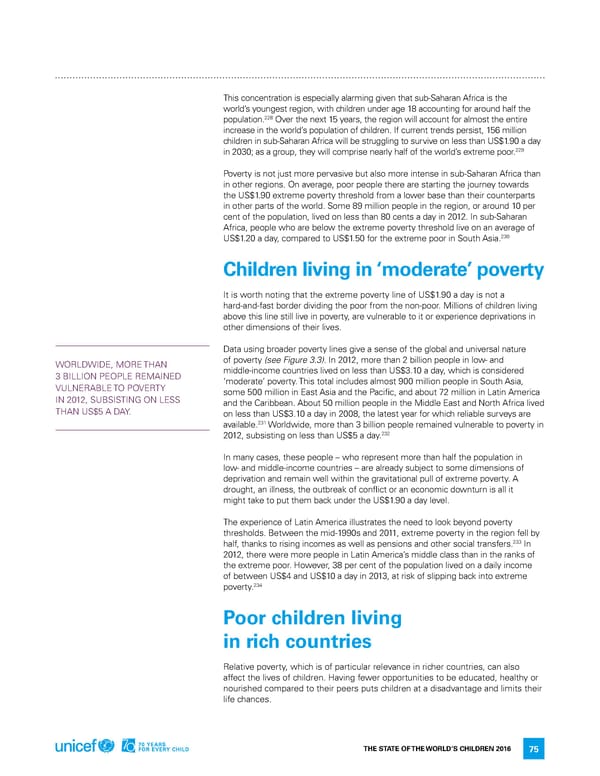This concentration is especially alarming given that sub-Saharan africa is the world’s youngest region, with children under age 18 accounting for around half the 228 population. over the next 15 years, the region will account for almost the entire increase in the world’s population of children. if current trends persist, 156 million children in sub-Saharan africa will be struggling to survive on less than US$1.90 a day 229 in 2030; as a group, they will comprise nearly half of the world’s extreme poor. Poverty is not just more pervasive but also more intense in sub-Saharan africa than in other regions. on average, poor people there are starting the journey towards the US$1.90 extreme poverty threshold from a lower base than their counterparts in other parts of the world. Some 89 million people in the region, or around 10 per cent of the population, lived on less than 80 cents a day in 2012. in sub-Saharan africa, people who are below the extreme poverty threshold live on an average of 230 US$1.20 a day, compared to US$1.50 for the extreme poor in South asia. Children living in ‘moderate’ poverty it is worth noting that the extreme poverty line of US$1.90 a day is not a hard-and-fast border dividing the poor from the non-poor. Millions of children living above this line still live in poverty, are vulnerable to it or experience deprivations in other dimensions of their lives. data using broader poverty lines give a sense of the global and universal nature WorldWide, More Than of poverty (see Figure 3.3). in 2012, more than 2 billion people in low- and 3 Billion PeoPle reMained middle-income countries lived on less than US$3.10 a day, which is considered VUlneraBle To PoVerTY ‘moderate’ poverty. This total includes almost 900 million people in South asia, in 2012, SUBSiSTinG on leSS some 500 million in east asia and the Pacific, and about 72 million in latin america and the Caribbean. about 50 million people in the Middle east and north africa lived Than US$5 a daY. on less than US$3.10 a day in 2008, the latest year for which reliable surveys are 231 available. Worldwide, more than 3 billion people remained vulnerable to poverty in 2012, subsisting on less than US$5 a day.232 in many cases, these people – who represent more than half the population in low- and middle-income countries – are already subject to some dimensions of deprivation and remain well within the gravitational pull of extreme poverty. a drought, an illness, the outbreak of conflict or an economic downturn is all it might take to put them back under the US$1.90 a day level. The experience of latin america illustrates the need to look beyond poverty thresholds. Between the mid-1990s and 2011, extreme poverty in the region fell by half, thanks to rising incomes as well as pensions and other social transfers.233 in 2012, there were more people in latin america’s middle class than in the ranks of the extreme poor. however, 38 per cent of the population lived on a daily income of between US$4 and US$10 a day in 2013, at risk of slipping back into extreme poverty.234 Poor children living in rich countries relative poverty, which is of particular relevance in richer countries, can also affect the lives of children. having fewer opportunities to be educated, healthy or nourished compared to their peers puts children at a disadvantage and limits their life chances. The STaTe of The World’S Children 2016 75
 70 Years for Every Child Page 91 Page 93
70 Years for Every Child Page 91 Page 93